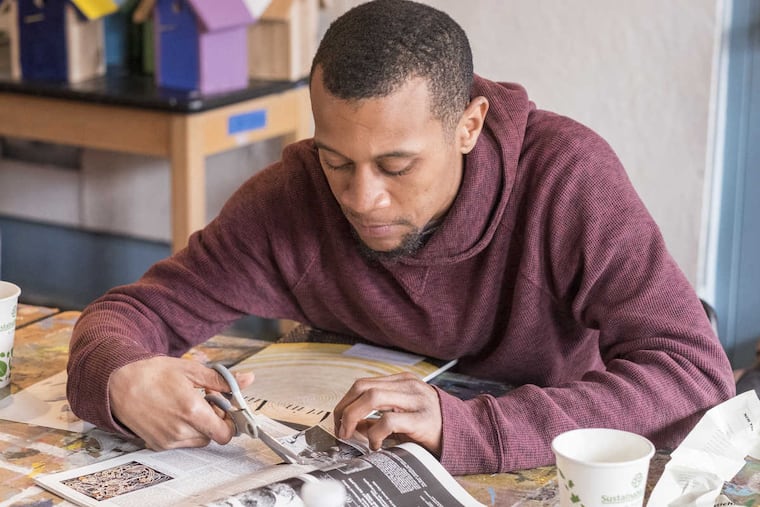How an area artist, a former inmate, is sharing his craft

When Jesse Krimes was sent to prison for drug dealing in 2009, he didn't know he would spend the next five years in confinement creating a name for himself in the art world.
The Lancaster artist also didn't know he would wind up teaching his craft to former inmates Monday as part of a project launched by Mural Arts Philadelphia.
"Art gave me a shot to have a job and get back on my feet," Krimes told the five formerly incarcerated participants who gathered Monday for the workshop at Mural Arts' headquarters on the 1700 block of Mount Vernon Street.
The project is called "Voices" and is meant to start conversations around issues of criminal justice by giving a voice to the imprisoned or recently released from prison.
The culmination of the numerous workshops will result in a mural on the facade of a two-story halfway house on the 700 block of Willow Street. The final work will be a collage of the participants' individual pieces of art, each depicting personal experiences with the criminal justice system.
"I designed this mural as a loose framework that will allow everyone to basically say what they want to say," said Krimes, who was released from prison in 2014.
Krimes always had a passion for art – he took art courses in high school and studied art at Millersville University in Lancaster County. He was arrested for possession with intent to distribute 145 grams of powdered cocaine in 2009, shortly after graduating from college.
Art kept Krimes sane over the next five years as he was transferred among maximum-security prisons in different states and spent almost a year in solitary confinement.
He would spend his days using the materials at hand – newspapers, prison soap, bedsheets – to create artwork he would smuggle out a piece at a time to confidantes. Two of the resulting pieces, "Purgatory" and "Apokaluptein: 16389067," were exhibited after his release, the first at the Palais de Tokyo in Paris and the other at Rutgers University's Zimmerli Art Museum.
"Someone like Jesse, he's got talent and we're able to become a vehicle to facilitate the blossoming of his talent," said Jane Golden, executive director at Mural Arts. "And now he can touch others and become a symbol to others of what is possible."
Participants were responsive to Krimes' art lesson, being able to identify with his history of incarceration.
One participant, Cierra Senior, 23, was arrested in 2013 for conspiracy, she said, without providing additional details. Originally from Willingboro, Senior spent most of her childhood in foster care and was a self-taught artist.
While serving a 24-month sentence in prison, Senior honed her craft by drawing and selling portraits to inmates for $10 a pop, something Krimes said he did as well.
"Even the warden asked me to draw him a portrait," said Senior, who hopes to attend college and study art and business after completing the Mural Arts program.
Omar Robinson, 32, has been to prison three times for drug dealing and possession of firearms. He was most recently released in 2016 and is on parole until December.
"I'm thankful for programs like these that get you back on track," said Robinson, of South Philadelphia. "It helps you express yourself through art and give back to the community in a beautiful way."
The participants are part of Mural Arts' paid apprenticeship called the Guild, which seeks to prevent reincarceration and help individuals meet their educational or employment objectives after leaving prison.
Apprentices are paid $9 an hour for their work creating participatory art spaces and murals in the city during a period of six to eight months.
The reentry program seems to be producing results.
An estimated 78 percent of participants who have been through the Guild have landed a job or gone to college afterward, according to Robyn Buseman, restorative justice program director at Mural Arts. And the recidivism rate, or the reincarceration rate of former inmates, was 15 percent in 2016, compared with the state average of 35 percent.